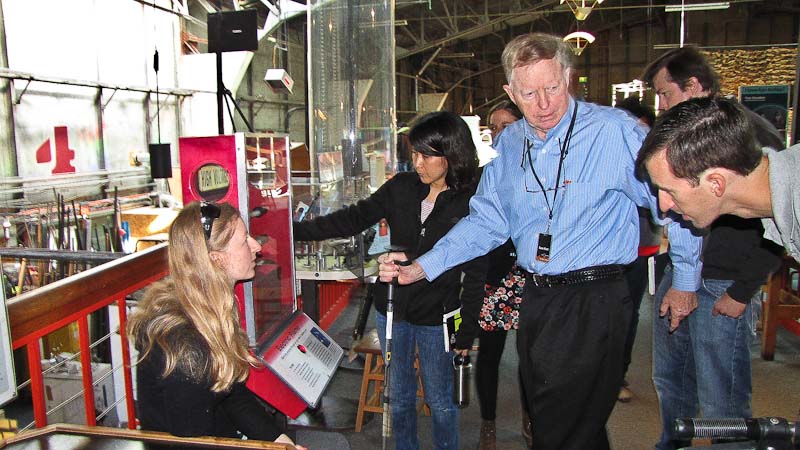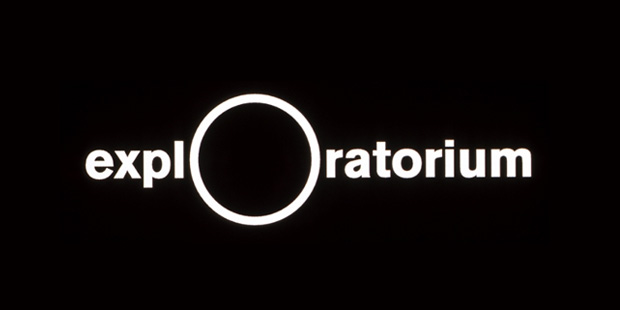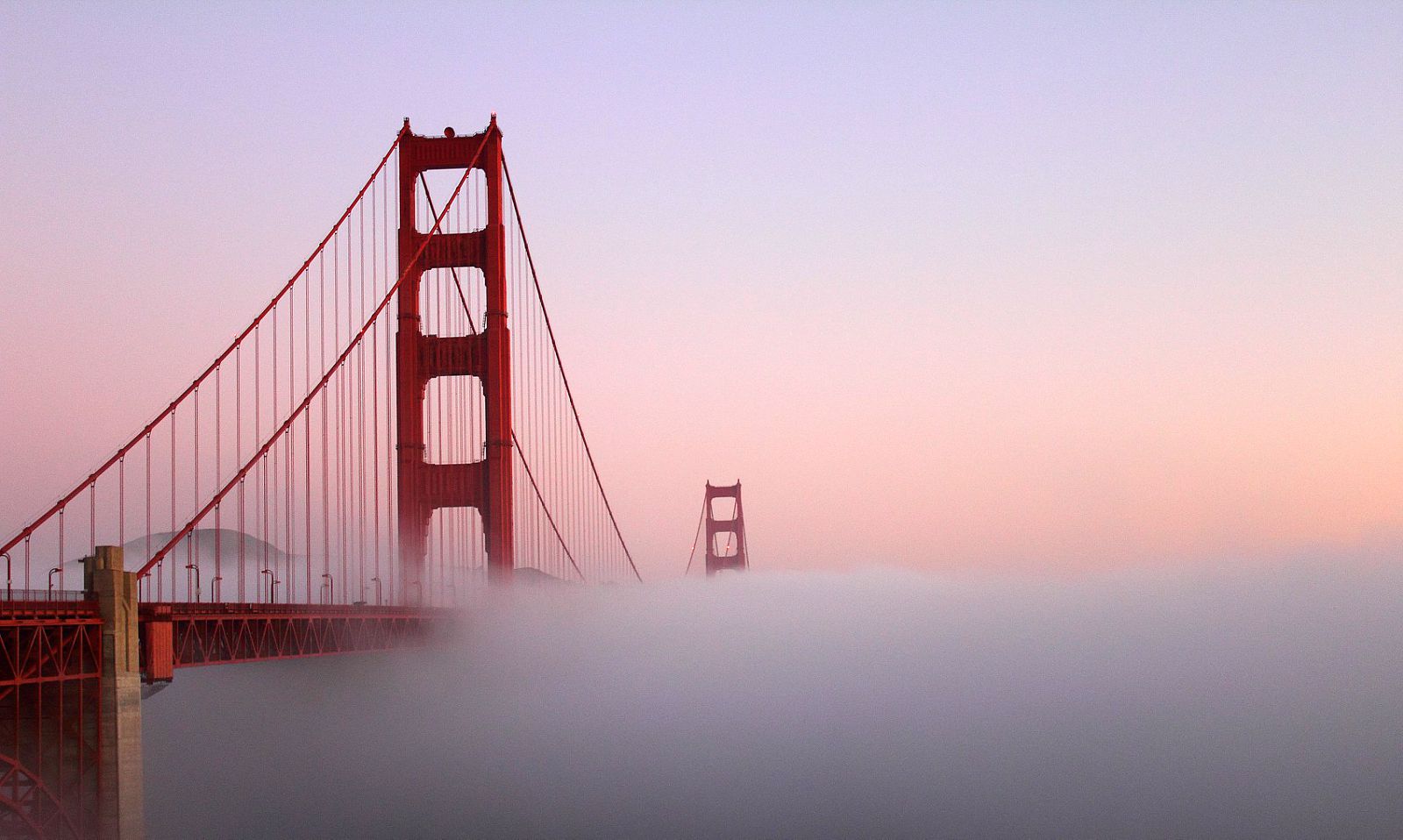 NSSL’s Dave Rust, Sean Waugh, and Susan Cobb spent two weeks at the San Francisco Exploratorium science museum as part of a NOAA Environmental Literacy grant to introduce staff and visitors to weather science. The following is a description of how a just a portion of time was spent, from Susan’s perspective.
NSSL’s Dave Rust, Sean Waugh, and Susan Cobb spent two weeks at the San Francisco Exploratorium science museum as part of a NOAA Environmental Literacy grant to introduce staff and visitors to weather science. The following is a description of how a just a portion of time was spent, from Susan’s perspective.“If you break it, it’s our fault,” proclaims the staff proudly. Intended to be a completely “hands-on, play with it, figure it out” type of experience, each exhibit is designed to be durable. There are few placards telling you what to do.
NSSL scientists were part of a unique NOAA education grant to educate SFO Exploratorium visitors about severe weather science. The project involved a week of orientation and planning in the fall, and two weeks in the spring. During those weeks we had a key to the museum, which made me a little giddy. Who gets a key to a museum?
Weather is not currently addressed at the Exploratorium, not directly anyway. We could show atmospheric movements in the “Fluid Trough,” and how thunderstorms form in the “Convection Currents” display. But in a year, the Exploratorium will be moving from their current site at the Palace of Fine Arts not far from the Golden Gate Bridge, to Pier 15 on the Embarcadero. There they WILL have a weather observatory, and NOAA has had a role in helping brainstorm ways to showcase weather.
“We can run around in it?” The ‘tornado machine’ immediately draws hands into its vortex of water vapor. Parents hold their children back until Exploratorium staff assures them it is okay. “Run around in it! Stand over the vent. Block the airflow. What happens?” An “Explainer” approaches with a bottle of bubbles and gently blows the bubbles into the funnel. Some get flung outwards towards the squeals of the children. Some rise up into the tube until they pop.
“What is it?”
“What do you think it is?”
“A tornado?”
“Yeah! An upside down tornado. How do you think it works?” We introduce them to moisture, rising air, ingredients for a thunderstorm. “What makes it spin?”
We move on to shear. “Feel the air coming out of those holes. Which direction is it going? How about over here? And at that other column? Do you know, we study tornadoes where I work?”
“Really? How? Why?”
“Well, we don’t really know how tornadoes start. I mean, we know what makes a big monster thunderstorm start to turn, but we don’t really know what makes that huge storm concentrate that energy into a smaller funnel.”
“Oh! I know!” A six year old sits next to me at the tornado machine and spends ten minutes explaining his theory on tornado formation. “The storm gets a lot of energy and pushes it together and explodes into a tornado!” This was the abridged version, but he went on to talk about how Zeus and Thor had roles too. He was from Italy.
“Oh! We just saw Tornado Alley at the IMAX theater!”
“Did you see that car over there in the movie?”
“Oh yes!”
“We take cars like that and drive them into storms! That one has hail dents the size of BASEBALLS! See that stuff on top? Those are weather instruments so we can measure the storm as we drive through. How else do you think we could study storms? They’re kind of big and dangerous so we have to be clever.”
“Could you fly through the storm?”
“Well, we do sometimes, but it’s bumpy and dangerous.”
Puzzled looks.
“Well, see that big plastic bag up there? It is a huge weather balloon! We attach instruments to it and fly it into the storm! Wanna see a launch? See this instrument? What do you see? It got struck by LIGHTNING while it was attached to that balloon! Do you wanna know what these instruments do?”
“Whoa! That’s so cool!”
“I’m from Joplin,” said another visitor. We went on to talk what happened May 22, 2011. Her eyes were haunted. “A tornado has come too close to me before. I took shelter. I don’t know why others didn’t.”
“Well we are looking into that problem right now. We have meteorologists and social scientists, emergency managers and engineers all talking about ways to solve it.”
“Oh, I am so glad to hear that. Please keep doing this work.”
“Those are the clouds over the earth right now?”
“Yup! This is called Living Earth, an app on the iPad. Do you see any curly ques?”
“I see a curly que!”
“Yeah! That’s a storm! Over Antarctica! Let’s see what it looks like there right now. Oh! There IS a storm! Look how snowy it is! But here is another place in Antarctica away from the storm. See the icebergs?”
“Those are icebergs right now?”
“Yup! Wanna see a volcano? This is Kilauea in Hawaii. See the smoke? If you check back at night, you can see it glow!”
I knew I had connected when one in a crowd of first graders put her hand on my shoulder (I was sitting on the floor with them), and asked if she could tell me a story about weather.
“Of course!”
The Exploratorium has been hesitant to delve into the world of technology, including iPads, to enhance the visual experience. But I think we showed how it could work. From sharing photos of tornadoes, lightning or clouds, to YouTube videos of balloon launches or live current radar where severe weather was occurring, people were fascinated. Many adults would get out a piece of paper and write down the names of the apps I would show them.
“Do you have any games on your iPad?” from a little boy.
Well, okay, not everyone.
I sometimes stood near the “cloud in a bottle” demonstration. Increasing the air pressure in a clear soda bottle with some water in it, and releasing the pressure to produce a little puff of vapor can hardly compete with the popular cow eye dissection that occurs most days on the hour. But it was fun to connect the cloud demonstration with what was happening outside. Don’t remember what the sky was like before you came in? There’s an app for that! Let’s look!
But that was just a small part of our time. Mornings, even on the weekends, were spent conducting “trainings.” These were special sessions with floor staff called “Explainers” who facilitate the visitor experience. During these times, we would share our knowledge and experience, and answer their questions. They will translate this new knowledge to visitors after our residency was over.
Where’s Dave? The training was set to start at 9:30 a.m. on Sunday morning, with our retired storm electricity scientist showing how to use the Van De Graff generator to explain lightning. 9:40 a.m. Hmmm. Our hostess is missing too. Daylight Savings time had left me in front of a roomful of teenagers. Alone! I wasn’t going to tackle atmospheric electricity on my own, but I did have some questions. I’ve always wanted to work at a science museum. How in the world did these teenagers score this gig?
So I asked.
“My brother did it first. He loved it.”
“Really?” said their manager. “I didn’t know that!”
“I like science.”
“It sounded cool.”
“How did you, Susan Cobb, get into your career?”
“Well, the Wizard of Oz.”
“What?!? No way!”
“What do you want to be when you grow up?”
“Marine biologist.”
“Environmental scientist.”
“Science teacher.”
More than two thirds of the room wanted to pursue a career in science. But their enthusiasm was measured. Dave finally arrived.
“Will you give me a job?” one said.
“Do well in school,” was Dave’s fatherly answer.
“My kid loves weather! What did you have to study?”
“Math, lots of math.”
“Oh. He’s not good at math.”
“That’s okay, neither was I.”
“But you still did it?”
“Yes, the only thing I have ever wanted to do was be a meteorologist.”
“You need to talk to my son. Let me find him. Will you still be here?”
“What’s that?”
“Radar. I am looking to see if the rain is going to stop today in SFO. What do you think? Which way is it moving? What do the colors mean? Why are their pinks and blues over here? What? Snow in the Sierras? Let’s check the webcam at Lake Tahoe!”
The clang of a loud dinner bell gives the signal that the museum is closing for the day. The high school explainer team herds visitors toward the exits and shut down exhibits. Opening people’s eyes to the world around them. Making them curious about weather and weather phenomena. Sparking their interest in science. Answering their questions. Showing them research matters. Giving me confidence I do know something worth sharing. That’s what the NOAA Scientist in Residence program did for me.



